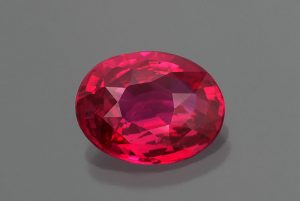Ruby
Ruby is the red to the pinkish-red variety of the Corundum mineral group that also includes Sapphire which is known primarily as the blue variety although it is available in many colors. Ruby is one of the top four gems (Diamond, Sapphire, Ruby, and Emerald) in popularity. This is mostly due to its beauty, intense color and toughness in jewelry. With a Moh’s hardness of 9.0 and no cleavage, it is a very durable gem for jewelry. Ruby’s red color is caused by minor amounts of trivalent Chromium (Cr) replacing Aluminum (Al) in the crystal structure. Pure Cr2O3 occurs in nature as the mineral Eskolaite, which is green.
Ruby is available from many locations around the world. Some of these locations such as Burma, Ceylon, and Madagascar, are well known for their fine Rubies.
| Category: | Oxide mineral variety (corundum) |
| Formula: | Al2O3: Cr |
| aluminium oxide with chromium | |
| Crystallography: | Trigonal – Hexagonal Scalenohedral |
| Crystal Habit: | Crystals hexagonal, prismatic or steeply dipyramidal, tabular, rhombohedral, rarely acicular, typically rough, to 1 m; sectorally striated on [0001] k [1011]. Also granular, massive. |
| Twinning: | Common lamellar k [1011], may be an exsolution phenomenon. Contact or penetration twins on [0001] or [1011], rare. |
| Cleavage: | None; Partings on [0001] and [1011] |
| Fracture: | Irregular/Uneven, Conchoidal |
| Tenacity: | Brittle |
| Hardness (Mohs): | 9.0 |
| Density: | 3.99 – 4.10 (g/cm3) |
| Luminescence: | None |
| Radioactivity: | Not Radioactive |
| Color: | Red to Pinkish Red; may be color zoned, asteriated |
| Transparency: | Transparent to Translucent, Opaque |
| Luster: | Adamantine to Vitreous, Pearly on partings |
| Refractive Index: | 1.760 – 1.772 Uniaxial ( – ); commonly anomalously Biaxial |
| Birefringence: | 0.008 – 0.009 |
| Dispersion: | 0.018 (low) |
| Pleochroism: | Weak to None |
| Other: | Asterism often present due to oriented needle-like inclusions or to colloidal or other material deposited in oriented tubules. |


